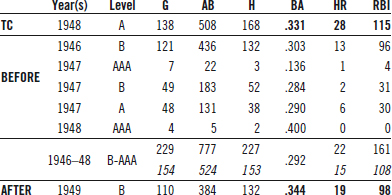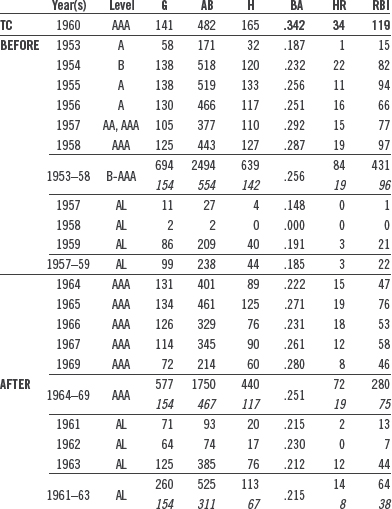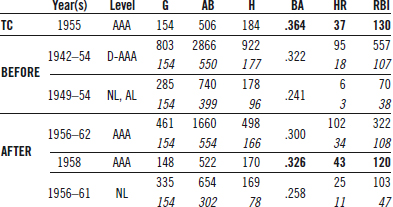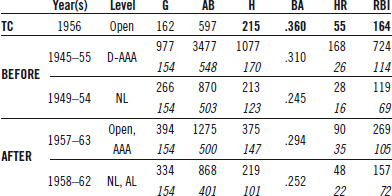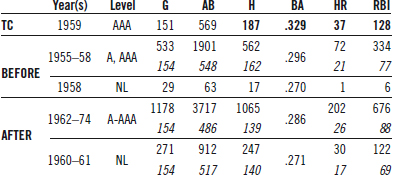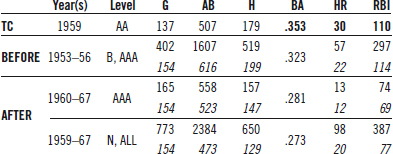Triple Crown Batters in the Minor Leagues (1946-62): What They Did Before and After
This article was written by Herm Krabbenhoft
This article was published in The National Pastime: Major Research on the Minor Leagues (2022)
One of the rarest and most highly regarded achievements for a hitter is winning the Triple Crown (TC)—leading the league in Batting Average (BA), Home Runs (HR), and Runs Batted In (RBI). In this article I present the minor league batters who won the Triple Crown from 1946 through 1962—the periods designated as “The Golden Age” of minor league baseball (1946-51) and “The Decline” (1952-62).1
This article is limited to those who earned their Triple Crowns in the top-three levels of play: Single-A, Double-A, and Triple-A. The focus of the article is on what the players did before and after reaching the Triple Crown pinnacle, especially Hal Summers and Larry Osborne. The before-and-after details for the other TC batters are summarized briefly, since there already are excellent SABR biographies for each of them.
RESEARCH PROCEDURE
The information presented for each of the players was culled from several sources: The Encyclopedia of Minor League Baseball, The Sporting News Official Baseball Guide, Baseball-Reference, Retrosheet, the SABR Biography Project, and newspaper articles. Whenever a statistics line given on the Baseball-Reference site had a blank cell for one or more of the critical stats (G, AB, H, BA, HR, RBI), I proceeded to ascertain the missing number(s) by using the statistics provided in The Sporting News Baseball Guide and/or by checking all of the pertinent box scores and game accounts provided in both The Sporting News and the newspapers published in or near the city of the player’s team.
Thus, for each of the players featured in this article I achieved complete minor league statistics (not including independent minor leagues, winter leagues, and instructional leagues, which were irrelevant to this research). The Appendix which follows this article provides the complete details for each of the 30 blank spaces I filled in. For the summary charts provided for each of the Triple Crowners, when the player’s total number of games in the before or after sections was greater than 154, I have also included the stats normalized to 154 games; these values are shown in italics.
HAL SUMMERS
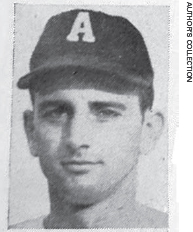 Hal Summers won the Triple Crown in 1948 with the Augusta Tigers (Class-A South Atlantic League). His circuit-leading batting average of .331 surpassed second-place finisher Edgar Hartness by six points; his 28 homers were a dozen more than runner-up Joseph Stringfellow’s 16; and his 115 runs batted in were 11 more than next-in-line Benjamin Taylor’s 104. Summers was chosen as an All-Star for the outfield; the other two All-Star flyhawks were Lloyd Merriman (.294 BA, 9 HR, 75 RBI) and Dick Burgett (.303 BA, 9 HR, 101 RBI).
Hal Summers won the Triple Crown in 1948 with the Augusta Tigers (Class-A South Atlantic League). His circuit-leading batting average of .331 surpassed second-place finisher Edgar Hartness by six points; his 28 homers were a dozen more than runner-up Joseph Stringfellow’s 16; and his 115 runs batted in were 11 more than next-in-line Benjamin Taylor’s 104. Summers was chosen as an All-Star for the outfield; the other two All-Star flyhawks were Lloyd Merriman (.294 BA, 9 HR, 75 RBI) and Dick Burgett (.303 BA, 9 HR, 101 RBI).
BEFORE: Summers was a star on the baseball diamond and the basketball court for San Diego State College, earning varsity letters for baseball in 1940, 1941, and 1942 and for basketball in 1941-42, 1942-43, and 1945-46. He was an All-Conference selection as an outfielder for the Aztecs in 1942, during which he compiled a .295 batting average (23 hits in 78 at bats) with two home runs and 19 runs batted in. After the 1942-43 hardwood season, Summers served in the military (US Army Air Corps) 1943-45. After his discharge, he returned to San Diego State in the fall of 1945. He again played hoops for the 1945-46 season, after which his teammates voted him “Honorary Captain”—the second-ranking team honor, “Most Valuable Player” being the highest honor.2
After that basketball season ended in 1946, Summers began his professional baseball career. He was initially signed by Cleveland on March 4 intending to “finish work for his college degree and report to Wilkes-Barre of the Class-A Eastern League, a Cleveland farm.”3 But on March 17 he was signed by Bakersfield, Cleveland’s farm club in the Class-C California League.4 However, on April 24, a week before the regular season was to begin, he was released.5 Two weeks later, on May 9, he was hired by Frisco Edwards, the manager of the Salem Senators of the Class-B Western International League.6
Edwards described Summers as “a power hitter.” Playing with Salem, Summers produced a .303 batting average with 13 homers and 96 RBIs in 121 games. As a flyhawk he fashioned a .972 fielding average, which ranked fifth among the 16 outfielders with at least 100 games.
Thanks to his solid 1946 performance, Summers began the 1947 campaign with the Triple-A Portland Beavers of the Pacific Coast League. But, after having played in just 7 of the first 26 games in which he went 3-for-22 (.136), he was optioned back to Salem. He responded with a .284 BA (52-for-183) in 49 games. At the end of June he was optioned again, this time to the Augusta Tigers, a Class-A farm club of the New York Yankees (South Atlantic League). Summers continued to perform solidly, producing a .290 BA (38-for-131) in 48 games. At the conclusion of the season, he was “recalled” by Portland and instructed “to report for another whirl with the club next year,” i.e. 1948.7 However, analogous to the 1947 campaign, after having seen limited action for the Beavers—2-for-5 in 4 of 12 games—he was farmed out. He appears to have been first offered to Denver, but the deal fell through and he was sent to a team at the Single-A level —again the Yankees farm club in Augusta, with whom he proceeded to win the Triple Crown.
AFTER: With a Class-A Triple Crown winner in their ranks, the Yankees wanted Summers to move up for the 1949 campaign to the Beaumont Exporters, their Double-A farm club in the Texas League. When Summers balked at this, Jack Maupin, the player-manager of the Meridian Millers in the Southeastern League (Class-B), intervened. Maupin and Summers had been teammates at San Diego High School. The Millers purchased Summers’s contract and he and Maupin became teammates again.8 Summers did not disappoint. He went on to lead the Southeastern League in batting average (.344, 19 points higher than runner-up John Tayoan’s .325), home runs (19, 3 more than second- place finisher Nesbit Wilson’s 16), and runs batted in (98, 2 more than silver medalist Benjamin Thorpe’s 96). Yes, Summers won another Triple Crown!
Summers was also chosen for the league’s end-of- the-season All-Star team. During the annual convention of the National Association (held in Baltimore, December 7-9), Summers was drafted by the Macon Peaches (Class-A South Atlantic League) — “Among the outstanding transactions of the winter was the drafting of Hal Summers by Macon.”9 Despite this success, and evidently feeling that a professional baseball career (in the minor leagues) was not in his best interests, he returned to San Diego State College as a graduate student. Having earned an AB degree in geography with a minor in sociology in June, 1946, Summers pursued studies in elementary education and in January, 1951 earned the requisite teaching credentials for the state of California. Subsequently, Summers continued his studies at San Diego State, earning the requisite state of California credentials for Education Administration (February 1953) and an MA in education (January 1957).10
Before the start of the 1951 season, the Greenville Spinners (Class-B Tri-State League) contacted Summers. An Augusta teammate of his, manager Vance Carlson, was hoping to get Summers back on the diamond. But Summers wired back that he was “definitely out of baseball and teaching school.”11 For the next 19 years Summers was with the Chula Vista, California, Elementary School District, serving as a teacher, principal, and director of special services.12 He passed away on September 12, 1970. The accompanying chart tabulates Summers’ 1948 Triple Crown and his before- and-after performances.
Hal Summers: Summary of His Triple Crown and Before-and-After Performances
LARRY OSBORNE
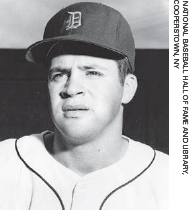 Larry Osborne won the Triple Crown in 1960 with the Denver Bears (Class-AAA American Association). His circuit-leading batting average of .342 surpassed second-place finisher Carl Yastrzemski by three points. His 34 homers were four more than runner-up Steve Boros (his Bears teammate) collected, and his 119 runs batted in were equaled by Boros. In an after-the-sea- son poll of American Association baseball writers, Osborne was chosen unanimously as the first baseman for the loop’s All-Star team.13 He was not, however, selected as the Most Valuable Player, that honor going to Boros.14
Larry Osborne won the Triple Crown in 1960 with the Denver Bears (Class-AAA American Association). His circuit-leading batting average of .342 surpassed second-place finisher Carl Yastrzemski by three points. His 34 homers were four more than runner-up Steve Boros (his Bears teammate) collected, and his 119 runs batted in were equaled by Boros. In an after-the-sea- son poll of American Association baseball writers, Osborne was chosen unanimously as the first baseman for the loop’s All-Star team.13 He was not, however, selected as the Most Valuable Player, that honor going to Boros.14
BEFORE: Scouted by Birmingham’s Bill Pierre while attending West Fulton High School in Atlanta, Osborne was signed by the Detroit Tigers on June 1, 1953.15 He then began his professional baseball career with the Montgomery Grays in the Class-A South Atlantic League, making his professional baseball debut on June 18. He entered the game in the seventh inning as a pinch hitter and was fanned by Savannah’s Courtney Stempel. In the ninth, he collected his first hit, a single. After getting two hits (both singles) in 27 at bats in his next eight games, he clouted his first home run off Columbia’s Maurice Fisher. He ended up with a .187 batting average (32 hits in 171 at bats) with one homer.
Larry Osborne: Summary of His Triple Crown and Before-and-After Performances
He continued his career in the minors for the next five years, culminating with a solid .287 batting average and 97 RBIs with the Charleston Senators (Triple-A American Association)—second only to loop-leading Earl Hersch’s 98. While Osborne had a couple of brief call-ups to the Big Show (11 games in 1957 and 2 games in 1958), he finally had a longer stay in the majors in 1959. But in his 86 games with the Tigers he managed to bat only .191 (40 hits in 209 at bats) and clout just three homers. So, it was back to the minors for 1960, during which he won the Triple Crown.
AFTER: Osborne was again back “to stay” in the majors starting in 1961. With the Tigers in 1961 and 1962, he compiled a batting average of .222 (37 hits in 167 at bats) in 135 games (mostly in pinch hitting assignments). Near the end of the 1963 spring training, the Tigers traded Osborne to Washington on March 23 for cash and a player to be named later (Wayne Comer). With the 1963 Senators he had his only full-time major league campaign, turning in a .212 batting average (76 hits in 358 at bats) in 125 games, primarily playing first base during the first four months, before being relegated to pinch hitting duties during August and September.
After that, it was back to the minors for the remainder of his playing career, through 1969. As given on the Baseball-Reference website, “Osborne turned to scouting full time for Kansas City in 1970. Over the next six years he scouted for the A’s, Boston Red Sox, Montreal Expos and Twins. In 1976, he took a position as a crosschecker for the Major League Baseball Scouting Bureau. He remained in the Bureau for 17 years before taking another scouting job with the San Francisco Giants.” With San Francisco, Osborne’s primary job was to report on the Giants’ opponents, a role which he carried out for some 16 years, and for which he merited a 2010 World Series ring. He passed away on April 15, 2011.16
The accompanying chart tabulates Osborne’s’ 1960 Triple Crown and his before-and-after performances.
ADDITIONAL TC WINNERS
The following charts provide the pertinent statistics for Triple Crowns achieved by Bob Lennon, Rocky Nelson, Steve Bilko, Alonzo Perry, Pancho Herrera, and Gordy Coleman.
Bob Lennon (1945-50, 1952-61) won the Triple Crown in 1954 with Nashville (Southern Association). SABR bio by Warren Corbett.
Rocky Nelson (1942, 1946-62) won the Triple Crown in 1955 with Montreal (International League) and also in 1958 with Toronto (International League). SABR bio by David Fleitz.
Steve Bilko (1945-63) won the Triple Crown in 1956 with Los Angeles (Pacific Coast League). SABR bio by Warren Corbett.
Alonzo Perry (1946-49, 1951, 1955-59, 1962-63) won the Triple Crown in 1956 with the Mexico City Reds (Mexican League). SABR bio by Dennis Degenhardt; see also Perry’s “Player info” from the Baseball-Reference Bullpen.
Pancho Herrera (1955-70, 1972, 1974) won the Triple Crown in 1959 with Buffalo (International League). SABR bio by Jose I. Ramirez; see also Herrera’s “Player info” from the Baseball-Reference Bullpen.
Gordy Coleman (1953-56, 1959-67) won the Triple Crown in 1959 with Mobile (Southern Association). SABR bio by Charles F. Faber.
CONCLUDING REMARKS
Of the eight Triple Crowners presented in this article, only one of them did not reach the major leagues—Hal Summers. While Alonzo Perry did not play in the American or National circuits, he did play in the Negro Leagues. Most of the players had so-so major league careers—only three of them accumulated enough at bats (plate appearances) in a given season to qualify for the batting championship in the majors—Steve Bilko (1953), Pancho Herrera (1960) and Gordy Coleman (1961 and 1962). None of the players achieved an “emboldened” (i.e., league-leading) positive batting statistic in the Big Show; Bilko and Herrera were NL leaders in strikeouts—125 (in 1953) and 136 (in 1960), respectively.
While none of the eight achieved the subsequent stardom in the major leagues one might expect based on their high-level minor league Triple Crown, the prestige of their minor league TC is indelible. Indeed, two of the players subsequently won a second Triple Crown in the minors—Summers 1948 and 1949 (Class-B). and Rocky Nelson (1955 and 1958).
HERM KRABBENHOFT, a SABR member since 1981, is a retired organic chemist. His baseball research efforts have included: ascertaining the complete details of major league triple plays (in collaboration with Jim Smith and Steve Boren), ultimate grand slam homers; minor league double-duty diamondeers, quasicycles, determining the accurate RBI records of Lou Gehrig, Babe Ruth, and Hank Greenberg, and Detroit Tigers uniform numbers. Herm’s baseball articles have appeared in several SABR committee newsletters, including The Inside Game, 19th Century Notes, and By The Numbers. He is the author of Leadoff Batters (published by McFarland in 2001). Krabbenhoft has been the recipient of three SABR Baseball Research Awards (1992, 1996, 2013).
Acknowledgments
I gratefully thank the following people at San Diego State University for their kind cooperation and superb efforts in providing me with pertinent information on Hal Summers’s academic education and athletic performance at San Diego State College: Adrian Aguilar, Alexis Flores, SaBrina White, Jim Solien, Jessica Rentta, and Stephanie Anderson. I should also like to thank Cliff Blau for reviewing the information provided in the Appendix and stating that everything appears correct (email dated January 4, 2022).
Notes
1. Lloyd Johnson and Miles Wolff, The Encyclopedia of Minor League Baseball (Durham, NC: Baseball America, 1997: 347, 411.
2. “Aztecs Nab Finale,” San Diego Union, March 04, 1946: 10.
3. “Cleveland Indians Sign Hal Summers,” San Diego Union, March 05, 1946: 12.
4. “Six new players have been signed by the Bakersfield Indians and will report for spring practice in April,” Bakersfield Californian, March 18, 1946: 11.
5. “Indians Will Play Sea Lions Tonight,” Bakersfield Californian, April 25, 1946: 5.
6. “Back to Bevos for B. Carney,” Statesman Journal (Salem, Oregon), May 10, 1949: 12.
7. “Beavers Call Players Back,” Oregonian, September 7, 1947: 27.
8. “The Barber Chair,” San Diego Union, May 10, 1949: 16.
9. Don Barton, “And How Is Sally?,” Columbus (South Carolina) Record, December 31, 1949: 6.
10. “Fifty-Third Annual Commencement, San Diego State College,” June 08, 1951, and personal communication from Registrar, San Diego State University, January 25, 2022.
11. Carter Latimer, “One In Half-Million,” Greenville (South Carolina) News, April 3, 1951: 10.
12. “Educator Summers Dies, Services Tuesday,” Chula Vista Star-News (California), September 13, 1950: 4. “Harold Summers Services Today, San Diego Union, September 15, 1950: 15.
13. “Two Georgians Make Triple A All-Star Team,” Atlanta Journal, November 05, 1960: 6. “New Omaha Chosen,” Omaha World-Herald, November 05, 1960: 9. “Four Denver Players on A.A. Team,” The Sporting News, December 14, 1960: 33.
14. Watson Spoelstra, “Ferrell Plots Tiger Course on Rebuilding,” The Sporting News, October 26, 1960: 29.
15. Leo MacDonell, “Ned Picked To Face A’s,” Detroit Times, June 2, 1953: 25.
16. Rick Badie, “Longtime Athlete was ‘Consummate Baseball Player’,” Atlanta Constitution, April 18, 2011: B6.
Appendix
There were eight players for whom I needed numbers for the games, at bats, hits, home runs, and runs batted in for each season they played baseball professionally (excluding independent leagues, winter leagues, and instruction leagues). The quickest source for the needed information is Baseball-Reference. Unfortunately, there are some blanks in some of Baseball-Reference’s stat lines. I have done the research to fill in the blanks for each of these eight players. For each of the eight players I present a chart with the information as presented on Baseball- Reference. Entries bracketed with asterisks and shown in *boldface-italics* are from my research and fill in the blanks. The sources of my entries are provided beneath each chart.
Hal Summers
The stats for 1947 Portland and 1948 Portland were obtained by going through the box scores for Portland as presented in TSN. I also corroborated the box score info by checking the pertinent game accounts as presented in the Oregon Journal and the Oregonian. Here are the particulars:
1947
April 23 TSN
1. Game on 4-11—1-for-5; single; 1-RBI.
2. Game on 4-12—0-for-3; 0-RBI.
April 30 TSN
3. Game on 4-17—1-for-3; double; 1-R; 2-RBI.
4. Game on 4-19—1-for-4; home run; 1-R; 1-RBI.
5. Game on 4-20 (1)—0-for-3; 0-RBI.
6. Game on 4-20 (2)—0-for-1; 0-RBI.
May 7 TSN
7. Game on 4-25—0-for-3; 0-RBI.
Additional Information
1. The Portland Beavers batting averages as presented in the Oregonian April 29, 1947 (p 31) show Summers with 22 AB, 3 H, 1 D, 1 HR, and 4 RBI, with a .136 BA.
2. The following was stated in the Oregon Journal April 29, 1947 (p 19)—“Hal Summers, outfielder, and Wandell Mosser, pitcher, will be turned over to the Salem Club.”
1948
April 14 TSN
1. Game on 4-03—0-for-1; 0-RBI.
April 21 TSN
2. Game on 4-09—1-for-1; single; 1-R; 0-RBI.
3. Game on 4-11 (1)—0-for-1; 0-RBI.
4. Game on 4-11 (2)—1-for-2; single; 0-RBI.
Additional Information
1. A list of players’ batting averages given in the Oregon Journal April 14, 1948 (p 38) shows Summers with 4 G, 5 AB, 2 H, 0 HR, and 0 RBI, with a .400 BA.
2. A list of batting averages for Beavers players given in the Oregonian April 22, 1948 (p 29) shows Summers with 5 AB, 2 H, and a Pct. of .400. Thus, there was no change from the prior week’s chart.
3. A list of batting averages for Beavers players given in the Oregonian April 28, 1948 (p 22) does not include Summers, indicating that he was no longer with the Portland team.
4. In my search of Portland box scores in TSN for the 12 games played between April 12 and April 26, Summers was not shown as playing in any of the 12 games.
CONCLUSION: I’m completely comfortable claiming that the entries for Summers for his time with Portland in both 1947 and 1948 are accurate.
Bob Lennon
The RBI stats for 1950 Jacksonville and 1952 and 1954 Nashville were taken from the stats given in the relevant editi ons of TSN BBG.
CONCLUSION: I’m completely comfortable claiming that the entries for Lennon for his RBIs in 1950, 1952, and 1954 are accurate.
Rocky Nelson
The RBI stats for 1942 Johnson City are taken from the “Final Appalachian Averages” presented in the John son City Press September 9, 1942 (p 7).
The RBI stats for 1952 Montreal are taken from the game account provided in the Montreal Star
April 17, 1952 (p 37): the box score of the April 16 game shows Nelson with 1 RBI; the text description states, “Don Hoak had doubled in the first heat and scored on a clout of similar dimensions by Rocky Nelson, the new first baseman.”
Thus, in addition to adding the 1-RBI to Nelson’s stat line, a “1” should also be entered in the “2B” cell. Moreover, as stated in the text description given in the Syracuse Post-Standard April 18, 1952 (p 25), for the game on April 17, “Don Hoak singled, Jim Gilliam doubled, and Rocky Nelson drew a base on balls to load the sacks. Jim Pendleton grounded to Claude Corbitt and the sliding Nelson turned his ankle as Benny Zientara was tagging him out. Thus, a “1” should be entered in the “BB” cell. The appropriate entries for OBP, SLG, OPS, and TB, etc. should also be made.
CONCLUSION: I’m completely comfortable claiming that the entries for Nelson for his RBIs in 1942 and 1952 are accurate.
Steve Bilko
The information for Bilko comes from the Allentown Morning Call:
1. August 21, 1945 (p 16): “…and Steve Bilko, a first baseman from Nanticoke, scouted by Benny Borgman, has also been signed by the Allentown club.”
2. August 22, 1945, through September 09, 1945: Bilko did not appear in the box scores in any of the 17 games played by Allentown.
3. September 10, 1945: Bilko played in the first game of the season-ending double header, the box score showing that he played left field with the following statistics: 1 AB, 0 R, 1 H, 0 O, 0 A, 1 Run batted in, and 1 Two-base hit. Bilko did not play in the second game.
CONCLUSION: I’m completely comfortable claiming that the entries for Bilko for 1945 are accurate.
Alonzo Perry
The 1951 HR and RBI statistics come from checking the box scores in TSN and as well as the game accounts in the Syracuse Post-Standard for all of Syracuse’s games for the April 19-May 29 period. Here are the details of Perry’s 9 games:
1. April 21: 0-0-0, 0-RBI (walked as PH).
2. May 01: 1-0-0, 0-RBI (PH).
3. May 04: 1-0-0, 0-RBI (PH).
4. May 05: 4-2-3, 1-RBI (1B).
5. May 06 (1): 4-1-1, 1-RBI (1B).
6. May 06 (2): 3-0-0, 1-RBI (1B).
7. May 07: 4-0-1, 0-RBI (1B).
8. May 09: 0-0-0 (1B, defensive replacement).
9. May 13: 1-0-0, 0-RBI (PH).
The 1963 stats are from TSN BBG.
CONCLUSION: I’m completely comfortable claiming that the entries for Perry for 1951 and 1963 are accurate.
Pancho Herrera
The 1966 BA is that shown in TSN BBG for Herrera’s time with both Syracuse and Columbus.
The 1968 stats for AB, H, BA, HR, and RBI are those shown in TSN BBG for Herrera with Ciudad del Carmen.
CONCLUSION: I’m completely comfortable claiming that the entries for Herrera for 1966 and 1968 are accurate.
Gordy Coleman
The RBI entry for 1954 is from TSN BBG.
The HR and RBI entries for 1955 are from going through the box scores in TSN; here are the details for Coleman’s 4 games:
1. Sept. 03: 1-for-5, 0 HR, 0 RBI.
2. Sept. 04: 0-for-4, 0 HR, 0 RBI.
3. Sept. 05 (1): 3-for-4, 0 HR, 0 RBI NOTE: one of his hits was a double; adjust TB and SLG accordingly.
4. Sept. 05 (2): 0-for-4, 0 HR, 0 RBI.
CONCLUSION: I’m completely comfortable claiming that the entries for Coleman for 1954 and 1955 are accurate.
Larry Osborne
The 1964 BA is that shown in TSN BBG for Osborne’s time with both Toronto and Atlanta.
CONCLUSION: I’m completely comfortable claiming that the BA entry for Osborne for 1964 is accurate.



